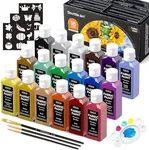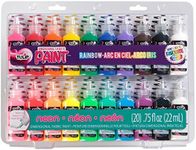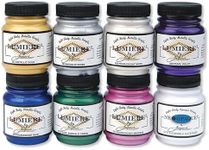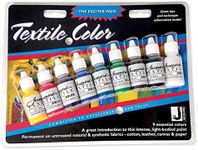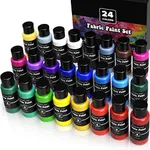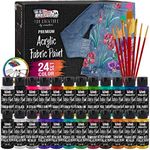Buying Guide for the Best Fabric Paints
Choosing the right fabric paint can make a significant difference in the outcome of your project. Whether you're customizing clothing, creating home decor, or working on a craft project, understanding the key specifications of fabric paints will help you select the best product for your needs. Consider the type of fabric you'll be painting on, the desired finish, and the durability required for your project. Here are some key specifications to consider when choosing fabric paints.Type of PaintFabric paints come in various types, including acrylic-based, dye-based, and fabric markers. Acrylic-based paints are versatile and can be used on most fabrics, providing a durable and flexible finish. Dye-based paints are absorbed into the fabric, making them ideal for soft, natural fibers like cotton. Fabric markers are great for detailed work and are easy to use. Choose the type of paint based on the fabric you're working with and the effect you want to achieve.
OpacityOpacity refers to how much the paint covers the fabric. Opaque paints provide solid coverage and are ideal for dark fabrics, while transparent paints allow the fabric's color to show through and are better suited for light fabrics. If you want vibrant, solid colors, go for opaque paints. For a more subtle, blended look, transparent paints are the way to go.
FinishThe finish of fabric paint can be matte, glossy, or metallic. Matte finishes are non-reflective and give a more natural look, while glossy finishes add shine and make colors pop. Metallic finishes contain reflective particles that give a shimmering effect. Choose the finish based on the look you want to achieve. Matte is great for a classic look, glossy for a bold statement, and metallic for a touch of sparkle.
Drying TimeDrying time is how long it takes for the paint to dry completely. Some fabric paints dry quickly, within a few hours, while others may take up to 24 hours or more. Quick-drying paints are convenient for projects that need to be completed quickly, but they may require more careful application to avoid mistakes. Longer drying times allow for more blending and detailed work. Consider your project timeline and the level of detail you need when choosing a paint with the appropriate drying time.
WashabilityWashability refers to how well the paint holds up to washing. Some fabric paints are machine washable and can withstand multiple washes without fading or cracking, making them ideal for clothing and other items that will be laundered frequently. Others may be more suitable for decorative items that won't be washed often. If your project involves items that will be washed regularly, look for paints labeled as permanent or machine washable.
Application MethodFabric paints can be applied using brushes, sponges, stamps, or spray bottles. Brushes and sponges are great for detailed work and larger areas, while stamps and stencils can create consistent patterns. Spray bottles are useful for covering large areas quickly and creating gradient effects. Choose the application method that best suits your project and your level of comfort with the tools.
